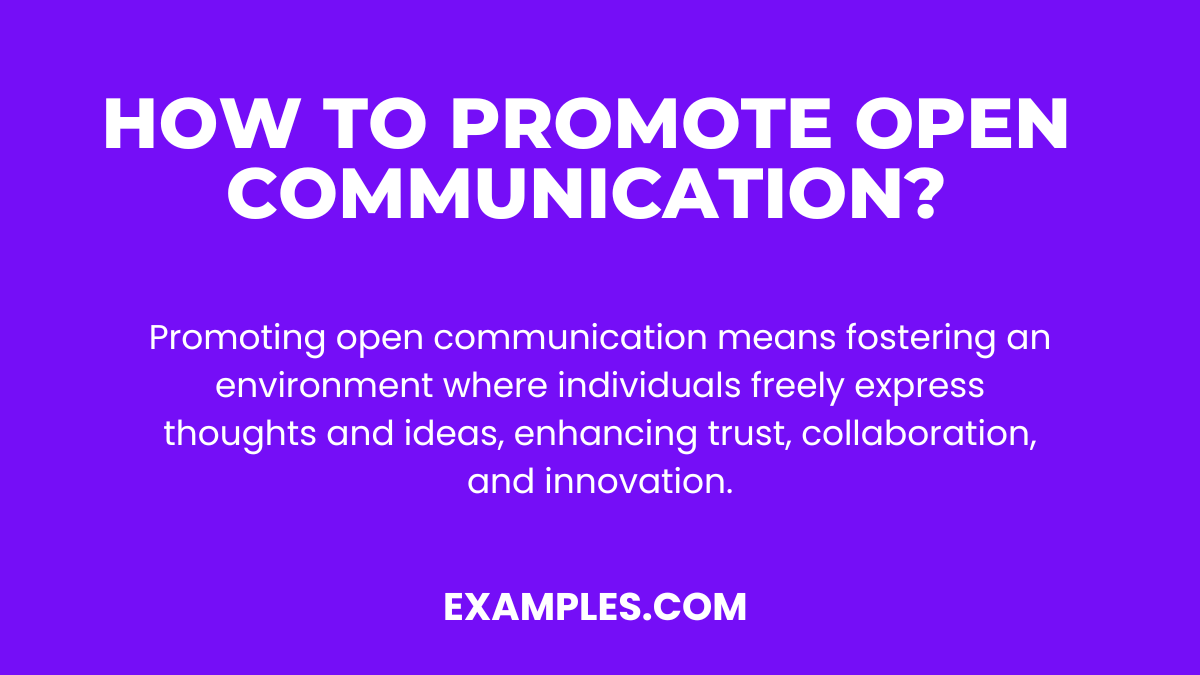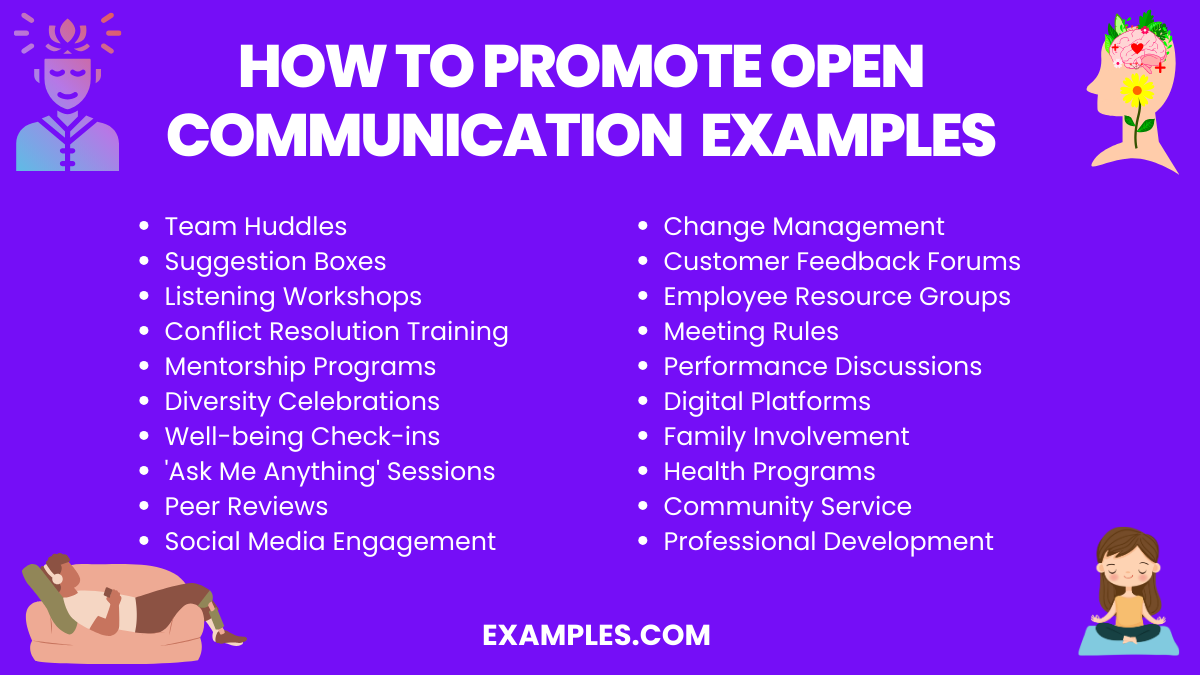How to Promote Open Communication – 19+ Examples,
Embark on the journey to a more collaborative and transparent workplace with this comprehensive guide on promoting open communication. Delve into practical strategies and real-world Communication Examples that demonstrate the transformative power of fostering an environment where dialogue flourishes, ideas are respected, and everyone feels heard. Learn to implement these tactics for a more engaged and efficient team.
Download How to Promote Open Communication at Work PDF
How to Promote Open Communication? – Meaning

How to Promote Open Communication refers to the strategies and practices that encourage honest, transparent, and effective dialogue within an organization. It involves creating an atmosphere where team members feel safe to express their thoughts, ideas, and concerns without fear of judgment or repercussion. This aspect of open communication is essential in building a culture of trust, enhancing collaboration, and driving innovation. By promoting open communication, organizations can improve problem-solving, decision-making, and overall team morale.
20 How to Promote Open Communication Examples

Explore 20 dynamic examples illustrating how to promote Open Mind Communication in various settings, from workplaces to personal relationships. Each example sheds light on common communication barriers and offers practical solutions for creating a more open, transparent, and collaborative environment. By addressing the specific causes of closed communication and implementing these targeted strategies, you can significantly enhance open dialogue and understanding in your organization, leveraging the power of How to Create Culture of Open Communication at Workplace. Embrace these strategies to unlock the myriad Open Communication Benefits, enhancing understanding, productivity, and trust wherever you apply them.
- Regular Team Huddles: Cause: Siloed information. Fix: Hold brief daily or weekly meetings to share updates and encourage Open Communication in the Workplace.
- Anonymous Suggestion Boxes: Cause: Fear of speaking up. Fix: Provide anonymous ways to share feedback, promoting Honest Communication.
- Active Listening Workshops: Cause: Misunderstandings. Fix: Train teams in active listening skills to ensure everyone feels heard and understood.
- Conflict Resolution Training: Cause: Inevitable workplace conflicts. Fix: Equip teams with the skills to handle disputes constructively, highlighting the Importance of Open Communication.
- Mentorship Programs: Cause: Lack of guidance. Fix: Pair less experienced employees with mentors to foster dialogue and learning.
- Cultural Diversity Celebrations: Cause: Cultural misunderstandings. Fix: Host events that celebrate different cultures, enhancing Open Communication in Relationship.
- Employee Well-being Check-ins: Cause: Unaddressed personal or professional issues. Fix: Regularly check in on employee well-being to support Open Communication in Healthcare environments and beyond.
- Leadership ‘Ask Me Anything’ Sessions: Cause: Hierarchical barriers. Fix: Schedule open Q&A sessions with leadership, embodying open communication quotes and principles.
- Peer Review Sessions: Cause: Lack of feedback. Fix: Encourage peer-to-peer reviews for continuous improvement and collaboration.
- Social Media Engagement: Cause: External communication gaps. Fix: Use social media platforms for open dialogue with clients or the public.
- Transparent Change Management: Cause: Organizational changes. Fix: Clearly communicate changes and reasons, reinforcing why open communication is important in workplace settings.
- Customer Feedback Forums: Cause: Customer dissatisfaction. Fix: Create spaces for customers to provide feedback and suggestions.
- Employee Resource Groups: Cause: Lack of representation. Fix: Support groups that give voice to diverse employee populations.
- ‘No Interruption’ Rules in Meetings: Cause: Dominating voices. Fix: Implement rules that allow everyone to speak and be heard.
- Regular Performance Discussions: Cause: Unclear expectations. Fix: Have clear, ongoing conversations about performance and goals.
- Digital Communication Platforms: Cause: Remote work challenges. Fix: Use digital tools to keep teams connected across distances.
- Family Involvement Activities: Cause: Work-life balance issues. Fix: Include family-oriented events to understand employees’ backgrounds better and promote open communication in family.
- Health and Wellness Programs: Cause: Physical and mental health barriers. Fix: Address overall health to improve focus and openness at work.
- Community Service Projects: Cause: Isolation from the community. Fix: Engage in projects that connect the team with the broader community.
- Professional Development Opportunities: Cause: Stagnation and lack of motivation. Fix: Offer growth paths to keep employees engaged and communicative.
How to Promote Open Communication in Workplace
Promoting open communication in the workplace is essential for fostering a collaborative and innovative environment. It involves creating channels for dialogue, encouraging transparency, and building trust among team members. By implementing the following strategies, you can cultivate a more engaged and efficient workforce.
- Designate Communication Champions: Assign team members to be communication facilitators. “Let’s make sure every voice is heard in our team discussions.”
- Regular ‘Town Hall’ Meetings: Conduct company-wide meetings for updates and Q&A. “Your questions and insights today will shape our path forward.”
- Feedback-Oriented Performance Reviews: Shift performance reviews to a two-way dialogue. “I’d like to understand your perspective on your progress and challenges.”
- Technology for Collaboration: Introduce tools that facilitate easy and efficient communication. “This platform will help us stay connected and collaborate more effectively.”
- Skill Building Workshops: Conduct workshops on communication skills like empathy and active listening. “Enhancing these skills will improve our teamwork and project outcomes.”
How to Promote Open Communication for Employees
Encouraging employees to communicate openly is vital for their engagement, satisfaction, and productivity. It empowers them to share innovative ideas, feedback, and concerns, leading to a more vibrant and dynamic workplace. Incorporating strategies like How to Promote Open Communication, nurturing Open Communication in Family like atmosphere at work, leading by example through Open Communication in Leadership, understanding the dynamics of Open Communication with Parents and Open Communication with Child to create a sensitive and supportive environment, are all steps towards building a culture of open communication. Each strategy not only enhances the individual’s ability to communicate but also strengthens the overall communicative fabric of the organization.
- Personalized Check-Ins: Regular one-on-one meetings to understand individual needs. “I’m here to listen and support your professional journey.”
- Group Ideation Sessions: Facilitate brainstorming sessions for collective problem-solving. “Every idea brings us closer to an innovative solution.”
- Encourage Peer-to-Peer Recognition: Allow employees to acknowledge each other’s contributions. “Recognizing our colleagues’ efforts fosters a positive team environment.”
- Develop a Feedback Culture: Make giving and receiving feedback a norm. “Let’s view feedback as a tool for our mutual growth.”
- Facilitate Work-Life Harmony: Discuss and respect personal boundaries and needs. “Understanding each other’s personal commitments creates a supportive work culture.”
How to Promote Open Communication Within a Diverse Team?
Promoting open communication within a diverse team harnesses a wealth of perspectives and fosters a rich, innovative environment. Recognize the unique backgrounds and viewpoints each member brings to the table to create a truly inclusive atmosphere.
- Cultural Sensitivity Training: Educate the team on cultural awareness to prevent misunderstandings and encourage Open Communication with Manager.
- Diversity Forums: Hold regular discussions on diversity and inclusion, allowing everyone to express their views and experiences.
- Inclusive Language Guidelines: Establish and promote the use of inclusive language to make all team members feel welcomed.
- Tailored Communication Styles: Understand and adapt to different communication preferences, acknowledging the Open Communication vs Direct Communication styles.
- Celebrate Diverse Holidays: Acknowledge and celebrate a variety of cultural holidays to show respect and appreciation for all team backgrounds.
What Strategies Can Leaders Implement to Encourage Open Communication?
Leaders are pivotal in shaping a culture of open communication. Their strategies and behaviors set the standard for the entire organization, promoting transparency, trust, and collaboration.
- Model the Behavior: Exhibit open communication yourself as a leader. Your actions will set a precedent for Open Communication with Stakeholders.
- Transparent Decision-Making: Involve team members in the decision-making process to demonstrate value and trust.
- Regular Open Forums: Create spaces where employees can speak freely about any topic, addressing the Open Communication vs Closed Communication dynamic.
- Recognition of Open Communicators: Acknowledge and reward those who actively participate in open communication, encouraging others to do the same.
- Feedback Systems: Implement a robust feedback system that allows anonymous and honest communication, ensuring everyone’s voice is heard.
What Role Does Feedback Play in Promoting Open Communication?
Feedback is vital in promoting open communication as it ensures continuous improvement, understanding, and adjustments in communication strategies, fostering growth and Open Communication with Students.
How Can Individuals Improve Their Skills in Promoting Open Communication?
Individuals can improve open communication skills by practicing active listening, engaging in empathy training, and seeking diverse perspectives to enhance Open Communication with Colleagues.
What Are the Key Indicators of a Workplace with a Culture of Open Communication?
Key indicators include regular and constructive feedback, high employee engagement, transparent decision-making processes, and a trustful environment that values each contribution.
In conclusion, promoting open communication is vital for fostering collaboration and understanding. Through real-life examples, we’ve seen how it leads to improved teamwork, innovation, and problem-solving. Recognizing signs of Poor Communication is crucial, and solutions lie in active listening, trust-building, and addressing Barriers to Communication. By embracing these principles, individuals and organizations can create environments where open communication thrives, leading to increased productivity and stronger Importance of Open Communication in Relationships.



